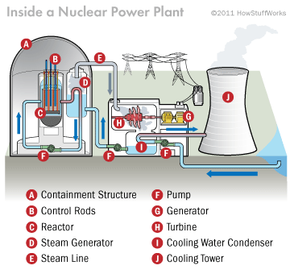Nuclear Reactor Components
There are several different types of nuclear reactors, but they all have some common characteristics. All of them have a supply of radioactive fuel pellets -- usually uranium oxide, which are arranged in tubes to form fuel rods in the reactor core [source: World Nuclear Association].
The reactor also has the previously mentioned control rods -- made of neutron-absorbing material such as cadmium, hafnium or boron -- which are inserted into the core to control or halt the reaction [source: World Nuclear Association].
Advertisement
A reactor also has a moderator, a substance that slows the neutrons and helps control the fission process. Most reactors in the United States use ordinary water, but reactors in other countries sometimes use graphite, or heavy water, in which the hydrogen has been replaced with deuterium, an isotope of hydrogen with one proton and one neutron [source: World Nuclear Association, Federation of American Scientists]. Another important part of the system is a coolant -- again, usually ordinary water-- which absorbs and transmits heat from the reactor to create steam for turning the turbines and cools the reactor core so that it doesn't reach the temperature at which uranium melts (about 6,900 degrees Fahrenheit, or 3,815 degrees Celsius) [source: World Nuclear Association]. (We'll explain why a meltdown is a very bad thing later in this article.)
Finally, a reactor is encased in a containment, a big, heavy structure, typically several feet thick and made of steel and concrete, that keeps radioactive gases and liquids inside, where they can't hurt anyone [source: World Nuclear Association].
There are a number of different reactor designs in use, but in the United States, about two-thirds of the reactors are pressurized water reactors (PWRs). In a pressurized water reactor, the water is pumped into contact with the core and then kept under pressure, so that it can't turn into steam. That pressurized water then is brought into contact with a second supply of unpressurized water, which is what turns to steam to turn the turbines. The remaining third of reactors in the United States are boiling water reactors (BWRs). With BWRs, the water that comes directly into contact with the reactor core is allowed to become steam for generating electricity [source: World Nuclear Association].
In the next section, we'll look at the potential risks nuclear reactors pose, and how to evaluate them.
